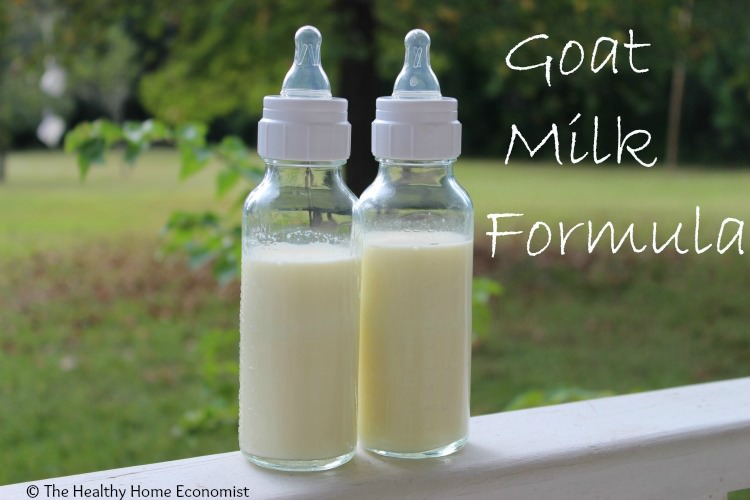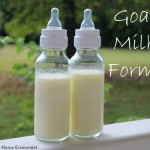How to make a nourishing homemade goat milk baby formula that mimics human breastmilk as closely as possible.

I nursed all 3 of my children exclusively until they started solid foods. In addition, I practiced extended breastfeeding, nursing each of my first two children for 2 years and the youngest for 4 years. I only used homemade formula occasionally such as after surgery.
I adored every. single. minute.
Nursing my children was a glorious experience the memories of which I will cherish forever! I’m sure most breastfeeding mothers would report the same.
The topic of homemade formula, even the more widely accepted goats milk formula, is a highly charged and controversial subject. In reality, it is a very important option for women to consider and have available who are not able to have a breastfeeding relationship with their baby.
This is because unpasteurized, donor breastmilk is not always available from reputable sources and in sufficient quantities to meet a baby’s growing appetite. A friend of mine is dealing with this very situation right now with her adopted daughter.
While she does her best to secure quality donor milk, the truth is that it isn’t enough, and she must supplement. Her first choice depending on local farm availability is formula made with raw goats milk as it seems to be digested a bit better by her baby.

Of course, all brands of commercial formula even if organic are best avoided if at all possible. The graphic above summarizes the problems with commercial formula quite succinctly.
Why Goat Milk is Healthy for Baby Formula
With commercial formula best avoided and relying solely on donor breastmilk a risky proposition, the homemade formula becomes an option well worth consideration.
But why goats milk formula in particular?
The reasons could be as simple as the availability of goat milk versus cow milk. The homemade formula is best made with a clean source of raw milk and some parts of the country have raw goat milk far more readily available than raw cow milk.
Another reason could be the digestibility of the formula. The natural homogenization of the fat globules and different structures of the goat milk proteins do make it easier to digest for some babies.
If a baby has trouble with a homemade formula made from raw grass-fed cow milk, for instance, then the next best option would indeed be goats milk formula.
I always suggest to mothers to try homemade formula made with cow milk first.
This is because although goat milk is wonderfully rich in brain-building fats, it must be used with caution in infant feeding.
Unlike cow milk, goat milk lacks folic acid and is low in the nutrient vitamin B12 both of which are critical to the proper growth and development of a baby.
Fortunately, if goats milk formula does indeed become the necessary choice, the inclusion of small amounts of nutritional yeast and organic grated or desiccated liver in the formula easily remedies this dilemma.
Infant Formula?
Below is the recommended recipe for goats milk formula as published by the Weston A. Price Foundation and originally published in the cookbook Nourishing Traditions in 1996.
I personally know at least a dozen women who have used this recipe with great success when raw grass-fed cow milk was either unavailable or did not digest well for their baby.
*You can order all of the required ingredients for the homemade baby formula in one easy package from Radiant Life by clicking here.
Because the goat formula contains liver powder, be sure to use bottle nipples that are designed for thicker flowing liquids. You can get them here.

Homemade Goat Milk Formula Recipe
A nourishing homemade goat milk formula made from goat milk, yogurt or kefir devised and tested by Dr. Mary Enig that matches the nutritional profile of breastmilk as closely as possible.
Ingredients
- 2 cups raw goat milk OR whole goat milk yogurt
- 1 7/8 cup filtered water
- 1/4 cup liquid whey
- 4 Tbl goat lactose
- 1/4 tsp bifidobacterium infantis powder
- 2 Tbl raw or pasteurized cream
- 1/2 tsp cod liver oil unflavored
- 1/4 tsp butter oil unflavored
- 1 tsp sunflower oil preferably organic
- 1 tsp extra virgin olive oil preferably organic
- 2 tsp virgin coconut oil preferably organic
- 2 tsp nutritional yeast
- 2 tsp raw chicken liver OR 1/4 tsp desiccated liver powder
- 2 tsp gelatin
- 1/4 tsp acerola powder
- 1 tsp molasses optional
Instructions
-
Fill a 2 cup Pyrex measuring cup with filtered water and remove 2 tablespoons (this will give you 1 7/8 cup water).
-
Pour about half the water into a pan and turn burner on medium.
-
Add the gelatin and lactose and let dissolve, stirring occasionally.
-
When gelatin and lactose are dissolved, remove pan from heat and add the rest of the water to cool.
-
Stir in the coconut oil and butter oil until melted.
-
Put remaining ingredients in a glass blender. Be sure to use only liquid whey and never powdered whey from making cheese as it will curdle the goat milk formula.
-
Add the water mixture and blend for about 3 seconds.
-
Pour goats milk formula into glass baby bottles or a large glass jar and refrigerate.
-
Before giving to baby, warm glass bottle in a pan of hot water or a bottle warmer (I like these). Never microwave baby bottles!
Recipe Notes
Do not substitute pasteurized milk or goat milk powder as these are heavily processed, denatured and allergenic foods. You may use plain, whole milk goat kefir or homemade goat yogurt in place of the milk portion of the milk if raw goat milk is not available in your area. Whole Foods has a quality brand of goat milk kefir available.
Cow lactose may be substituted for the goat lactose.
Do NOT use ultrapasteurized (UHT) cream. It is highly allergenic. Raw or pasteurized cream is acceptable.
Use only organic, unrefined, low oleic, cold pressed sunflower oil for this recipe. The brand linked to in the ingredients list is recommended.
The raw chicken liver should be frozen for 14 days or longer as recommended by the USDA for safe consumption. It is easiest to grate raw liver when it is frozen! Alternatively, 1/4 tsp of raw, desiccated liver powder may be substituted (find it here).
Collagen powder may be substituted for the gelatin in a pinch (more on peptides in baby formula in this article).
Use the optional molasses only if baby has issues with constipation. Only use as needed.
Homemade Goat Milk Formula Video
Below is an instructional video I filmed for the Weston A. Price Foundation on how to prepare a homemade formula yourself. Enjoy!
More Information
Homemade Nondairy Baby Formula
Why Soy Formula Even if Organic is So Dangerous for Babies
Traveling with Homemade Baby Formula
Feeding an Adopted Baby Without Commercial Formula
State Threatens to Take Baby Over Homemade Goat Milk Formula
Goat Milk Versus Cow Milk








By ” high quality cream” do you mean higher fat content? I am using 35% fat ( whipping cream, pasteurized ) iI am unable to buy raw. I thought that should keep him satisfied longer but it doesn’t . May I use more of the cream?
I wouldn’t use more pasteurized cream. Again, he is probably just going through a growth spurt. Eating every 2 hours is normal when that occurs for a baby that young.
Hi Sarah! I am getting my whey filtered off from the kefir just fine now! My baby is growing so well too on this formula, however, he only wants 4 ounces at each feeding, but is hungry again every 2 hours even through the night ( he is 3 months old). Any suggestions?
He’s probably going through a growth spurt. This causes more frequent feedings for a short time. If he is feeding well and growing on the formula, that is great!
Thanks for your reply!
I’m curious how long a batch can be kept in the fridge. I am currently exclusively breastfeeding my 5 month old, but my supply is dropping and I’m concerned I will need to supplement. I want to be prepared if that’s the case, but I will also still aim to have the bulk of her food be breastmilk. Thank you for posting this recipe!
2 days max. This formula is best made fresh every day.
Thank you!
I mean kefir grains, NOT the other kind of grains such as wheat, barley etc.
Yes, you can use whey from kefir.
Hi, is milk heated to 145* F considered ” low temperature pasteurized “? I just read that this is way too high and should not be over 100*F!!
Milk heated to 145F is definitely pasteurized! Even low temp pasteurization or “vat” pasteurization is unacceptable milk for this formula as all the probiotics and enzymes have been destroyed by the high heat.
The kefir comes through the filter, not cloudy but almost the same appearance as the kefir. ..very milky! I left the kefir on the counter and can see the whey separating fine! Do I still use the milky whey?
Perhaps you are using a cheesecloth that doesn’t have a fine enough mesh. Try using a flour sack cloth or white dishtowel to prevent the curds from slipping through. Or, just use the whey from a cup of plain whole milk organic yogurt from the store.
Thanks for answering! I am having difficulty separating the whey from the kefir. The kefir is quite liquidy and it filters through milky white. Should the kefir sit on the counter until it separates itself?
The whey filters through a tea towel quite easily from yogurt, but I am using the goat kefir because it is pasteurized at a lower temperature than the yogurt.
No, you should not leave the kefir on the counter … sometimes the whey is cloudy. This is fine. https://www.thehealthyhomeeconomist.com/whey-benefits-cloudy-or-clear/
Why do we need to add additional whey to the formula if We are using kefir instead of milk?
The reason you still add whey is that mother’s milk is higher in whey than cow’s milk even if that cow’s milk is fermented.